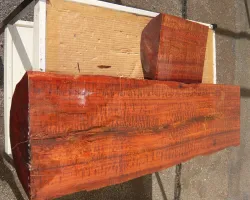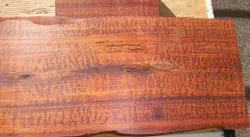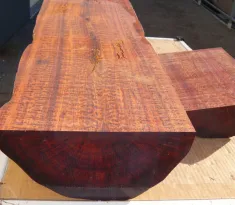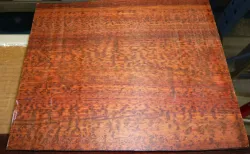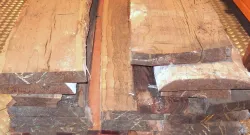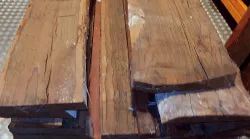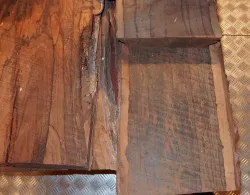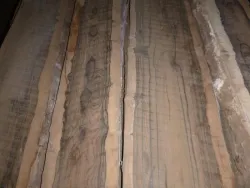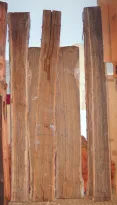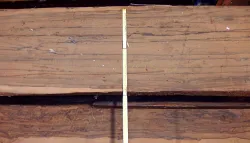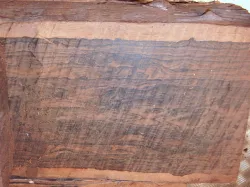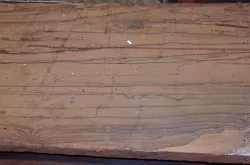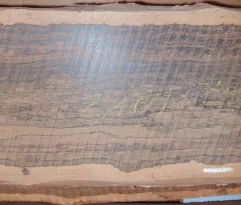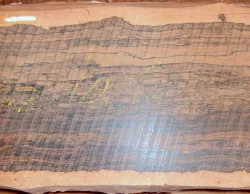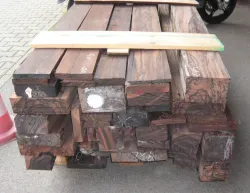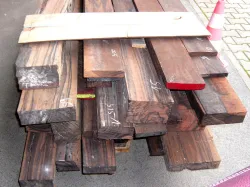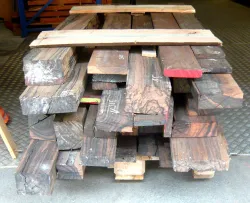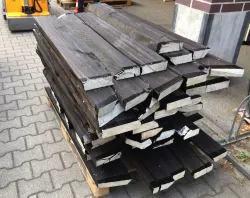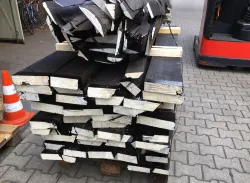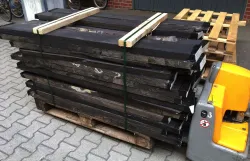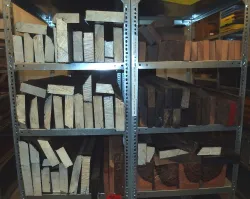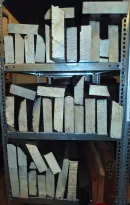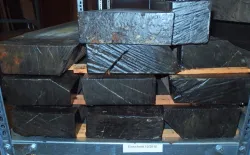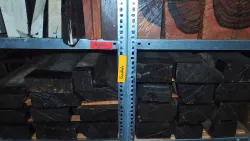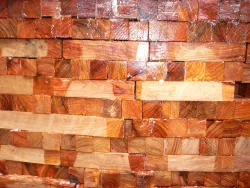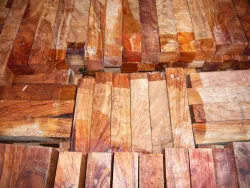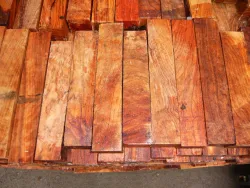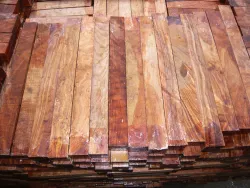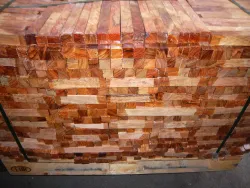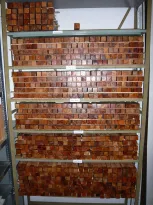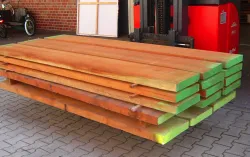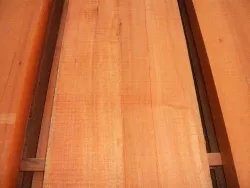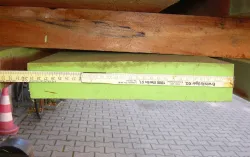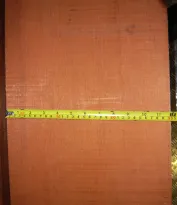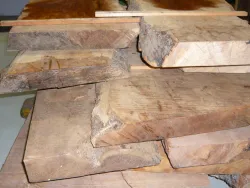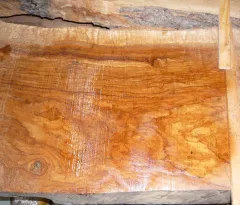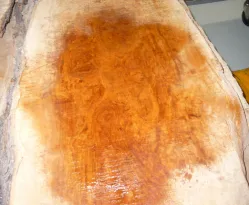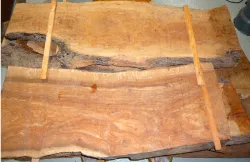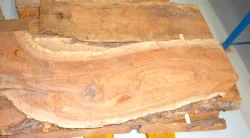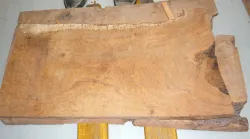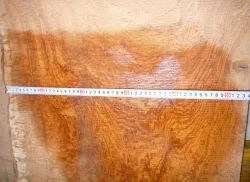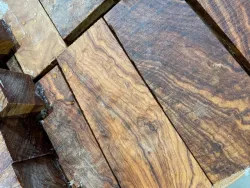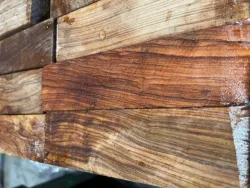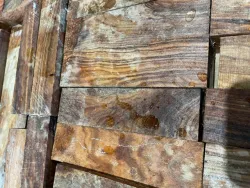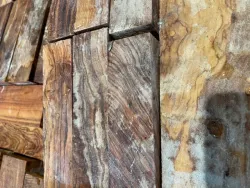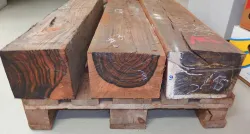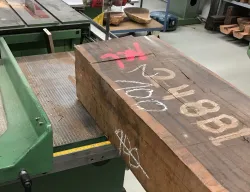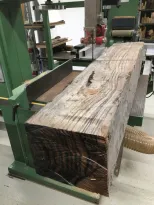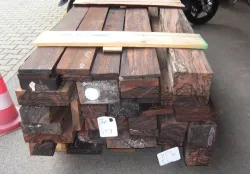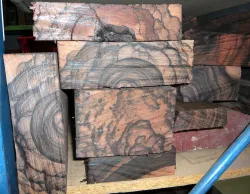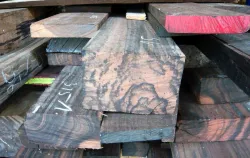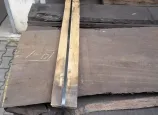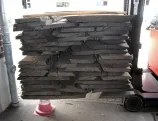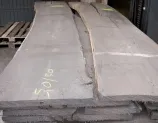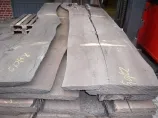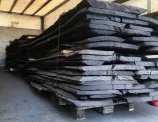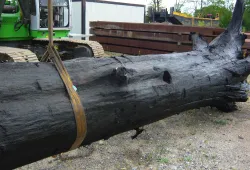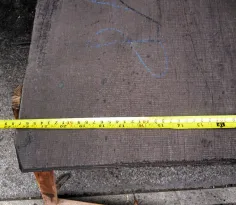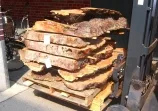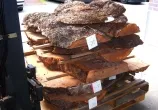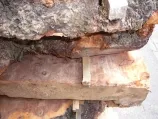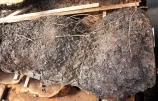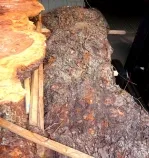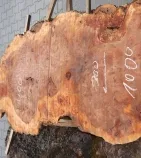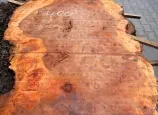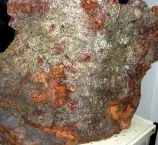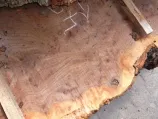Shipping country
Wood Species
News
Anyone who has ever dealt with snakewood knows the challenge that this wood presents: It is probably the most expensive and difficult wood to work with because of its unpredictable characteristics.
A log that looks beautiful from the outside can turn into an expensive disaster after the first cut, usually through the heart of the log in the middle: It is never possible to predict whether the mottling that is visible from the outside, which the wood must have, can also be found on the inside. If you were lucky and the fine grain is also found inside, it is far from certain that the distribution of the specks is also reasonably uniform. Often there are very nicely grained areas that are next to almost no grained parts at all, and that greatly detracts from the appeal.
And then there's the matter of the legendary cracks: snakewood is particularly prone to cracking due to its extreme density and hardness (it weighs about 1300 kg/m3), and it's a real art to make the cuts so that these cracks don't affect the finished product. Since the price is so exorbitantly high, offcuts and waste must be avoided as much as possible.
The log shown here is one half of a whole log weighing over 100 kilos, and although someone was in Suriname to inspect the log, the first cut was not made until after the purchase, which is a high risk.
In this case, however, all was well and this particularly thick trunk exceeded my expectations: I haven't had a log of snakewood that is so beautifully and evenly grained with few cracks (yet) in certainly 10 years, but that can still change at any time during its further drying.
I have a particularly bad memory of a batch of Ziricote that I bought as logs, then had them cut up into planks to be dried down to workable moisture content in a kiln. At first, everything looked good, the planks had little to no cracks, and you look forward to the expected cuts you can make from the beautiful planks.
Reality then caught up with me at the sliding table saw where the wide planks were to be rough cut. When the longitudinal edges were trimmed, the world was still fine, but the first cross-sections for cutting to length revealed the whole catastrophe: the planks were crisscrossed on the inside with several cracks that severely limited their usability. There was real frustration, including a rather desperate outburst of anger...all the work, the money, the long wait, the patience until the wood was dry - all for nothing. Since then, my relationship with Ziricote has been very split. I still love the wood, there is perhaps no other wood besides Brazilian rosewood that can have such crazy, bizarre and psychedelic grain patterns, the dark brown color with the black sharply defined lines is something very special. However, my experience with the severe cracking of this wood has greatly dampened my enthusiasm and rarely led me to buy this expensive wood again in any appreciable quantity.
But as it often goes in life, many a disappointed love can flare up again when circumstances are favorable. And that is now the case with us, I was able to buy a nice batch of this wood, and this time, amazingly, all went well between me and the bitchy wood: rarely have I seen such beautiful, crack-free and best grained Ziricote, it is simply a great pleasure to cut this wood. There are some spectacular scantlings and boards with stunning grain posted in the store now (2023-02), and surely there will be far more in the future. I am pleased to be able to offer you such beautiful wood as this Zirikote!
Large blocks with almost 20 - 30 cm diameter are an absolute exception, they have veneer quality and are simply beautiful. Coming soon to this webshop!
Technical drying in kiln works with ebony, but it is very slow, highly energy-intensive and not always as successful as the old-fashioned way of slow air drying.
We have been taking the slow and expensive route of air drying here since 2007, which ultimately produces the best quality wood, and for that you have to have a great deal of patience and money.
Any business economist will explain that warehouses must turn over as quickly as possible in order to make the maximum profit. What a nonsense that does not apply to the trade with expensive precious woods!
For our customers this means that they can always rely on air-dried woods that are unproblematic to work with, do not crack, hardly warp and thus represent the highest quality class.
In our storage rooms, temperatures of approx. 17 - 23 degrees with approx. 50-60 % relative humidity prevail in summer and winter, the warehouse is heated very moderately in winter and due to the meter-thick walls of the former cold storage room, the course of climate is very constant with little changes. This, of course, greatly benefits the drying of such valuable woods as ebony, rosewood and olive, and you, the customer, benefit from the owner's more than 30 years of experience in the wood trade.
We usually track the drying of woods by regularly weighing individual marked pieces from a lot. From the course of this weighing data, it is then easy to see when the weight loss becomes slower and slower and thus a balance moisture content with the environment is reached. As an example, we show here a small slab from a lot of ebony purchased in 2018 from Nigeria. This piece still weighed 15.48 kg when it entered the warehouse, then after just under a year it weighed 13.78 kg, in April 2020 it was still 12.58 kg, then in 2021 in October it was still 12.10 kilos, and now in July 2022 it is still 11.70 kg. An overall weight loss of approx. 3.8 kg. The Gann Hydromette indicates 10.6%, and thus the wood from 2018 can now be processed without any problem.
Without exaggeration, these scantlings are among the most beautiful wood I have ever had: they are spectacularly colored, very fine and densely grained, indescribably fragrant, simply top quality.
The downer about this lot, however, is unfortunately that it is still relatively fresh and therefore needs to dry for some time before we will post these scantlings in the store. But if you look at these photos, you\'ll agree that it\'s worth waiting a bit until they\'re dried enough to be sold and processed.
Sometimes we are particularly pleased when we find treasures in the warehouse that have been put away for a long time and had to go through a lengthy drying process. This is exactly what happened to us with a batch of thick olive wood planks. These had certainly been stored for a couple of years since their visit to the sawmill, yet they were far too damp to sell with a clear conscience.
These olive wood planks are certainly some of the nicest we\'ve had cut to size in a long time. Very large widths, respectable lengths and then thick planks with 50-60 mm thickness: it is a real pleasure to rediscover this treasure after a few years of drying.
By the way, this olive wood is not comparable to other wood from normal Spanish or Italian olive trees: it comes from a very special small-fruited olive species that grows almost exclusively on Corfu: the tree belongs to the Linaoleia family, a variety that grows unusually tall, often reaching heights of up to 20 meters. These trees have a long history dating back to the 16th century. Brought by the Venetians, these trees of the Lianoleia variety grow strongly in height and form strong trunks with rich foliage. Their wide distribution was the result of measures taken by the Venetian government, which rewarded the planting of young olive trees with high premiums. This led to an impressive increase in the number of olive groves on the island. The oils obtained were mostly burned in oil lamps, the tiny olives of this variety with their high yield were the first choice for this purpose, and since you can wait for them to fall voluntarily from the trees in autumn, you can still find dense forests of the trees as tall as houses on Corfu.
It is believed that all the cities on the Adriatic Sea occupied by the Venetians were illuminated with the illuminating oil produced on Corfu and exported from there. Certainly, the expansion of olive groves was at the expense of the cultivation of wine, cereals and vegetables, so that the Corfiotes were forced to import these species from the opposite mainland.
Once again we have had great luck and were at the right place at the right time: a larger old batch of very beautiful Makassar wood was for sale and despite the high price we did not hesitate. In all likelihood, it will hardly ever be possible to buy something like this again on the market, because Indonesia has long ago imposed an export ban on all unprocessed wood. For this reason, well-grained Makassar has been extremely difficult to obtain on the wood market for a long time, and often it is only very narrow boards that can be bought at high prices.
Such large blocks with a diameter of almost 30 cm are an absolute exception, they have veneer quality and are simply beautiful. As the pictures show, the result after ripping was better than could be expected with much optimism; such perfectly figured and almost completely crack-free Makassar is rare. As always: Coming soon in this webshop!
Bog oak in itself is not rare at all, almost every day in Northern Europe during earthworks, excavations, river deepenings, dredging in gravel and sand pits, logs are found stuck in the ground, usually even a real nuisance for the workers. A log that is stuck in the ground, often weighing several tons, is not so easy to remove, and usually a crane has to be brought in to help.
When this nuisance is finally removed, the log is salvaged and the work can continue, the next question is: where to put the debris? Even if the log is still reasonably intact and not completely decomposed and cracked, a rapidly progressing process of decay and cracking now begins, which can lead to the complete destruction of the wood in a short time, especially in warm weather.
It is possible to wrap the logs in plastic sheeting, but this almost always starts a rotting process with fungal growth and mold; it is possible to sprinkle the wood permanently with a sprinkler and thus preserve the condition for a time, but immediate cutting of the log into planks and boards at the sawmill has been found to be a safe method of making this valuable material usable. However, bog oak logs are not at all popular with sawmills, in most cases there is sand or small stones in the wood, which quite reliably ruin any expensive saw blade...
Now, for the first time, the color of bog oak can be judged: the most sought-after is, of course, a deep black color, which, however, only comes about under the fortunate interaction of various factors such as wood ingredients, iron ions, oxygen exclusion and bog water. Very often bog oak logs are colored only light yellow-gray, brown to gray, which, of course, are much lower rated colors. After cutting in the sawmill, the logs are then stored for years in different rooms with varying degrees of humidity until, after several years, multiple restacking, relocation to other rooms and a great deal of patience, they are eventually dried to the point where they can be exposed to normal climatic conditions. Under these normal conditions, the wood then dries down to a relative humidity of about 10%, so that the bog oak can then be further processed like normal wood.
Drying naturally creates great stresses in the wood which can result in extreme warping, cracking and warping, you can find some photos of such crooked pieces in the photo gallery. So drying must simply be done very slowly and gently with constant monitoring of wood moisture content. Despite careful drying, more or less severe cracks can always be found in bog oak wood, also rotten spots or spots discolored by fungi have to be cut out of the wood, so in the end only about 30-50% of the salvaged wood can be processed. The larger and longer the dimensions of the desired cuttings become, the more the scrap increases, and recurring cracks can increase the amount of scrap to be sorted out to 80-90%. We use this wood for a variety of applications, and even the scraps, offcuts and minimally defective pieces that occur when cutting fixed dimensions are combined in assortments and sold, this thousands of years old prefossil material is simply worth treating it with special respect!






